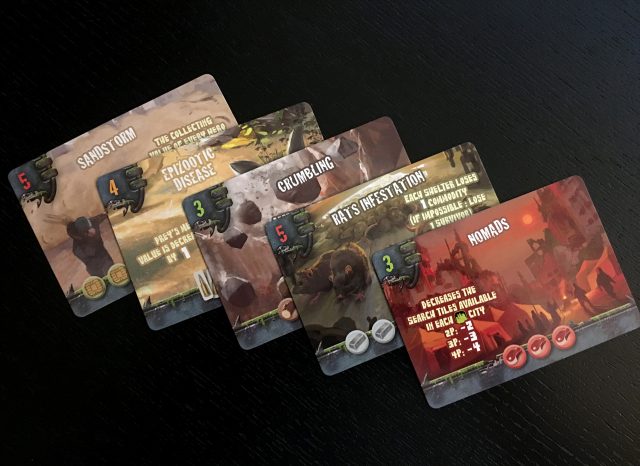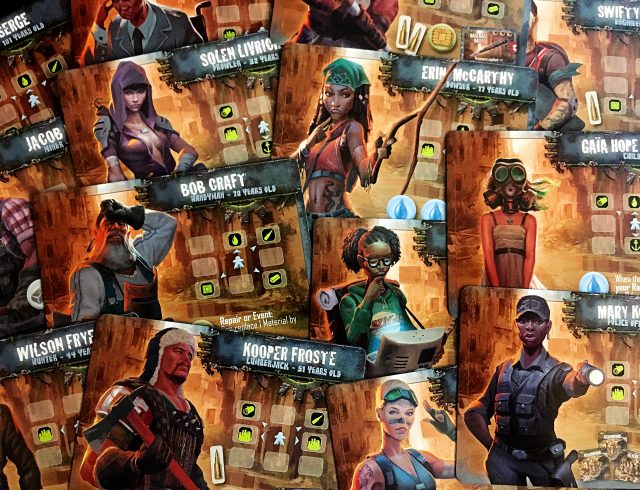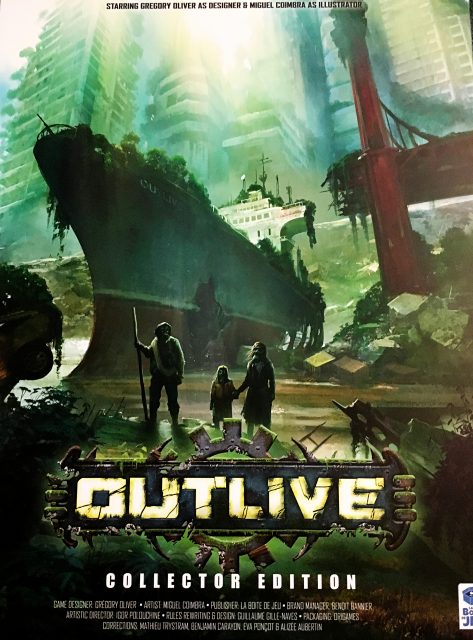Since at least the flood stories of Noah and Gilgamesh, humankind has always obsessed about the end of the world. The bombing of Hiroshima on August 6, 1945 sparked the emergence of modern nuclear Apocalyptic and post-Apocalyptic fiction, with books like A Canticle For Leibowitz and movies like Dr. Strangelove.
In tabletop world has contributed to this genre as early as 1977 with strategic games like After the Holocaust and of course Steve Jackson’s Car Wars, which let players get their Mad Max on.
The Fallout franchise is arguably the pre-eminent video game example of our fascination with the questions around “what if”. Fallout 4 made $750 million in the first 24 hours of its release in 2015. (Personally I prefer Fallout 3 and New Vegas, but ymmv.)
 This success has naturally led to a slew of games trying to cash in by trying to recreate a Fallout-like experience on the tabletop. This year we will even see the release of an official Fallout tactical minis game. Meanwhile, last year over in France, publishers La Boîte de Jeu Kickstarted the game I am going to talk about, which goes by the name of Outlive.
This success has naturally led to a slew of games trying to cash in by trying to recreate a Fallout-like experience on the tabletop. This year we will even see the release of an official Fallout tactical minis game. Meanwhile, last year over in France, publishers La Boîte de Jeu Kickstarted the game I am going to talk about, which goes by the name of Outlive.
On their website the game is described as “a management/survival game in a post-apocalyptic universe where nature has overcome its rights.” Um, yeah. Je pense qu’il faut là trouver un meilleur dictionnaire. Is it a good game? Join me and find out.
* * *
The narrative in Outlive is that you are the equivalent of a Vault Supervisor, in charge of keeping your Tribe prosperous and rad-free (or as rad-free as possible). But despite your best efforts, you’re losing the battle against the Wasteland. Your only hope is to join a convoy that will be arriving in your area in six days.
However, there are other Tribes in the area (your opponents) and the Convoy can (of course) only afford to bring one of you on board. “But how will they decide?” you ask. “Whoever has the most Survival Points (SP) after six turns,” is the answer. You earn SP by attracting survivors and keeping them as rad-free as possible, building rooms in your shelter, and fixing equipment.
 You start by picking a Leader and the Rooms you will eventually build from amongst a random assortment you are dealt. Your leader determines your starting resources, equipment, and the initial locations for your Heroes; the rooms you pick will determine your long-term strategy, as each has an ability which triggers once it’s built and filled with Survivors. There’s definitely some luck of the draw here, and new players will find it hard to optimize the synergies that can occur with certain combos of rooms and items. (I’m also wondering if an Agricola-like drafting mechanism for rooms might mitigate some of the luck factor. Hmmm.)
You start by picking a Leader and the Rooms you will eventually build from amongst a random assortment you are dealt. Your leader determines your starting resources, equipment, and the initial locations for your Heroes; the rooms you pick will determine your long-term strategy, as each has an ability which triggers once it’s built and filled with Survivors. There’s definitely some luck of the draw here, and new players will find it hard to optimize the synergies that can occur with certain combos of rooms and items. (I’m also wondering if an Agricola-like drafting mechanism for rooms might mitigate some of the luck factor. Hmmm.)
Each turn starts at Dawn by spawning in new resources onto the board and revealing a new Event, which is always bad and whose effects persist until it is “Solved” by somebody (that’s the extent of the co-op element in the game). Then Day breaks, and everyone’s Heroes move around the board getting Stuff. After this is over, Night falls: Events are Solved (or not), Survivors are fed, rads are managed, new Survivors are recruited, rooms are built, equipment is fixed, and food is spoiled. Then off to your bunk with you until the next day, and after the sixth day, no Sabbath for you! SP’s are counted and the winner joins the convoy.
The meat of the game is clearly the Day Phase. You have four Heroes which can move in either direction around the board’s eight locations, which are arranged in a circular track. There are usually two things to do at each location; usually one involves picking up whatever resources that area specializes in and the other involves scavenging for equipment or hunting. One space, the Cargo Ship, not only gives the first arrival each turn the right to be Start Player on the following turn, but also supplies canned goods (which do not spoil) and a free Survivor.
 There are two twists that Outlive adds to what would otherwise be a relatively straightforward worker-placement game. The first is the movement rules for your Heroes. They can only move a max two spaces per Day, they must move in order to take an action, but they can never end up in the same space as another of your Heroes. This isn’t quite a Mancala mechanic (as in, say, Trajan), but it does limit your freedom of choice, and always in a frustrating shit-I-didn’t-think-ahead kind of way.
There are two twists that Outlive adds to what would otherwise be a relatively straightforward worker-placement game. The first is the movement rules for your Heroes. They can only move a max two spaces per Day, they must move in order to take an action, but they can never end up in the same space as another of your Heroes. This isn’t quite a Mancala mechanic (as in, say, Trajan), but it does limit your freedom of choice, and always in a frustrating shit-I-didn’t-think-ahead kind of way.
The second is that your Heroes have different numeric Strength ratings (one 5, one 4, and two 3’s) which determine (a) how many Actions you can take in any particular area, and (b) whether and if they exert Pressure on opposing Heroes in the same space. When your Hero arrives in a new area, you get to shake down any players who’ve already arrived there earlier that Day, to the tune of one resource for every difference in Strength. Pressure can be modified by items and room effects, and it doesn’t necessarily play a huge role in the game–but it’s something you ignore at your peril. Plus, it’s fun to extort your friends!
The Kickstarter version includes decent Solo rules where you play against a Horde-bot who’s a bit of a doofus but who can make your life damned difficult. Plus, you can’t Pressure the Horde but (say it with me now in your best Dr Nick voice) “in Russia, Horde Pressure you.”
* * *
Outlive is a very good game. The way the theme is integrated throughout is really well done:
The game is medium-weight; currently, it’s rated almost exactly as heavy as Castles of Burgundy to give you an idea. That sounds about right. As in Castles, the game rewards picking a long-game strategy, but there are many paths to victory. Planning ahead, knowing when to head to the Cargo Ship to grab Start Player, and acquiring ways of mitigating bad luck are all important.
 In terms of player interaction Outlive hits the sweet spot for me. Between competition to pick up resources and items, Pressure, and solving Events there is enough to keep it from being multi-player solitaire but not so much to make it in-yo-face Take That.
In terms of player interaction Outlive hits the sweet spot for me. Between competition to pick up resources and items, Pressure, and solving Events there is enough to keep it from being multi-player solitaire but not so much to make it in-yo-face Take That.
The graphic design is evocative but effective, with a pleasant green-tinged palette for the gorgeous board and cartoony (but not goofy) renderings of Leaders. The Hero meeples that come with the game are cool (but the ones that come with the Collector’s Edition are awesome). The resource tokens are easy to distinguish and match the ones on Event cards, Leaders, and Items. The rules are well-organized and clear, with no ambiguities or holes I can recall.
However, there are some translation errors which are annoying, although none of them make the game harder to understand or play. The most glaring is “equipments”, which is used wherever the word “equipment” is meant–including the back of the “equipments” tiles. Totally minor, but something that could have easily been fixed at the proofing stage and detracts from the professional standard the game means to set.
Some questionable decisions were made in the production process. First, Prey tiles, which are meant to be randomly shuffled and stacked at each location so that only the top one can be seen at any time. Why then would you make them double-sided with the same info on both sides? Puzzling.
Next: for those (like me) who bought the Collector’s Edition, the upgraded Heroes, resource tokens, and storage boxes are gorgeous, like, to die for, but there are some issues. The slabs of meat, water cannisters, canned goods, and microchips are great, but the iron ore pieces are shaped like boxer-briefs and the wooden logs should have been grouped together like the bullets, so that (a) they don’t roll around, and (b) they don’t look like hamster turds.
The Strength ratings on the back of the Heroes are right-way-forward on the bottoms and from the front, but backwards on the back, so the “5” looks like a “2” and the “3” looks like an є–which is fine if we’re in Greece but otherwise confusing.
And the storage boxes for the components are sturdy and amusingly illustrated but most of them are far too large for what they have to contain and it’s not always obvious which box should hold what just by looking at them. Gamers like me like to be told how to store their goodies, not make decisions for goodness sake!
* * *
So does Outlive give you a Fallout experience? Well, to be fair, it doesn’t promise one exactly, although most of the tropes are there. If anything, the whole Shelter building and maintenance is more Fallout Shelter than Fallout. Still, big picture, Outlive is a really good game that is inviting to look at and fun to play. At this point, though, 2015’s Posthuman is the game that comes closest to providing a Fallout-like experience if that is what you’re seeking. But that, my friends, is a topic for another day.
[…] The Walking Meeple: As I wrote about a couple of weeks ago, dystopia is all the rage, and has been for some time. How many of us yearn for a simpler age […]